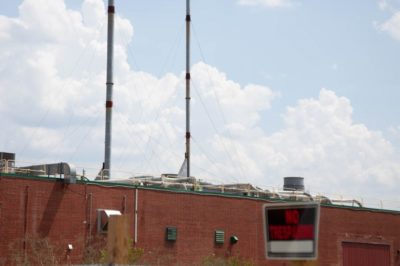Brenda Goodman is a senior news writer for WebMD. Andy Miller is editor and CEO of Georgia Health News.
Editor’s note: This story was updated Aug. 16 with additional details about the state’s plan to conduct air tests for ethylene oxide.
Metro Atlanta communities are moving forward with plans to test air around two sterilizing facilities amid public pressure and concern about toxic pollution releases in those areas.
The Cobb County Commission on Tuesday approved funding for independent testing around the Sterigenics facility in Smyrna. The commission is awaiting decisions by the Smyrna City Council and possibly the Atlanta City Council on whether they will split the cost of the test, which will sample ethylene oxide, according to the Marietta Daily Journal.
And east of Atlanta, the city of Covington said on its Facebook page that it is “still vetting possible air quality testing companies’’ as it plans to analyze its own air for ethylene oxide. The BD plant in Covington also uses the gas to sterilize medical products.

A city spokesman said Wednesday that the City Council is expected to approve testing at a Monday meeting.
Ethylene oxide is used on about half the medical devices that require sterilization, according to the Ethylene Oxide Sterilization Association. The chemical was classified as a cancer-causing substance in 2016 by the EPA.
On Friday, Georgia’s Environmental Protection Division (EPD) offered specifics about its plan to test the air around the sterilizing facilities. It will collect air samples in Smyrna and Covington every six days over the next several months. Each community will have four monitoring locations, ranging from a quarter mile to a mile from the plants. Results are expected in November.
Meanwhile, the EPD this week revealed results of an initial sample test for ethylene oxide at its south DeKalb County monitoring station. The agency said the test revealed an ethylene oxide concentration of 0.309 micrograms per cubic meter of air at that site, which is near I-285 southeast of the city of Atlanta.
In its report, the EPA cautioned that the sampling result was only an estimate because the testing equipment could not be properly calibrated.

Scientists who reviewed the report said the results suggested that the EPA had detected ethylene oxide (also known as EtO) in the air around metro Atlanta, but that the exact amount of the chemical and any potential sources were still unknown.
The level detected is roughly on par with the levels of ethylene oxide measured by the EPA in Willowbrook, IL, in the six weeks after the Sterigenics plant there was shut down on Feb. 15.
Experts interviewed about the sample result differed on its significance.
“It’s very difficult to measure such tiny amounts of chemicals in the air accurately,’’ said Janet McCabe, formerly the EPA’s acting assistant administrator for its Office of Air and Radiation, responding to a question about the south DeKalb test.

“In this case, apparently, the equipment had not been checked (calibrated), so while the scientists are confident that it correctly detected EtO, they are not confident in the exact reading,” McCabe said in an email.
The EPD said there is no known industrial source of ethylene oxide emissions – including the Sterigenics and BD plants — within 15 miles of the south DeKalb site.
The medical sterilizing industry has emphasized that there are other ways ethylene oxide can get into the air, including from diesel trucks and other vehicles.
Ethylene oxide disperses in outdoor air, but it doesn’t disappear for a long time. The chemical has a half-life of about 200 days in air, or almost 7 months. The half-life is the time it takes for just half of the chemical to break down.
The state’s report on the ethylene oxide sample did not include any data on wind direction at the time of the testing.
In an email, Richard Peltier, PhD, an associate professor of Environmental Health Sciences at the University of Massachusetts at Amherst, said the results are “not precise, and wouldn’t be legally defensible, but probably correct within 10 percent to 15 percent of the real value.”
“It would certainly be cause for alarm as this is 15 times higher than what the EPA considers safe.”
The toxic pollution issue in Georgia came to light after a report published last month by WebMD and Georgia Health News. The report said that last year, the EPA identified census tracts in the Smyrna area, just northwest of Atlanta, and in Covington, about 35 miles east of Atlanta, as having increased cancer risks, largely due to the use of ethylene oxide.
The Smyrna and Covington areas, which first heard of the ethylene oxide problem from the report, held recent town hall meetings where scores of residents called for air testing.

The Cobb Commission’s approval of funding for testing “is an important first step,’’ said state Sen. Jen Jordan, a Democrat who represents part of the Smyrna area. “I have every reason to believe that the city of Atlanta is willing to come to the table as well. Georgia EPD’s failure to inform the affected communities of the increased risk has delayed the process long enough. With the beginning of the school year, the need for immediate action has now become critical.’’
In response to public pressure, the state Division of Environmental Protection, which months ago told reporters that there were no plans to conduct testing of the air around sterilizing plants, has revised that position.
The EPD said this week that it’s purchasing portable air samplers and preparing a plan for monitoring in areas near known sources of ethylene oxide emissions. The agency added that it plans to conduct monitoring at a rural site in order to understand the differences between urban and rural concentrations.
U.S. Rep. Hank Johnson (D-Ga.), who represents the Covington area, has sent letters to the federal EPA and the state EPD, demanding answers on why his constituents were not informed about the chemical being released into the community’s air.
Concentrations of ethylene oxide in neighborhoods around the Covington plant range from 17 to 97 times the acceptable area concentration, or AAC, Johnson said in a letter to the EPA administrator, dated Monday.
“Despite EPA’s knowledge of the significant danger ethylene oxide poses, the agency has seemingly failed to mitigate the release of the toxin. Moreover, the EPA has not issued any press releases about these findings notifying residents living within exposed areas — failing to even notify families and communities that the very air they breathe could be poisonous,’’ the letter said.

The letter was also signed by U.S. Reps. David Scott and Lucy McBath, both of whom are Georgia Democrats, along with Reps. Susan Wild (D-Pa.) and Sheila Jackson Lee (D-Texas).

